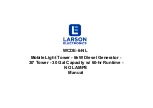
Output Voltage
2 V/Div, DC
Inductor Current
500 mA/Div, DC
Enable
5 V/Div, DC
Voltage at SW
2 V/Div, DC
Timebase - 200 μs/Div
V
I
= 2.4 V,
R
L
=50
Ω
Output Voltage
50 mV/Div, AC
Output Current
500 mA/Div, DC
Timebase - 2 ms/Div
V
I
= 2.5 V, I
L
=200 mA to 400 mA
Output Voltage
20 mV/Div, AC
Input Voltage
500 mV/Div, DC
Timebase - 2 ms/Div
V
I
= 2.2 V to 2.7 V, R
L
=50
Ω
Inductor Current
200 mA/Div, DC
Output Voltage
50 mV/Div, AC
Timebase - 100 μs/Div
V
I
= 3.3 V, R
L
=100
Ω
Inductor Current
200 mA/Div
Output Voltage
20 mV/Div
Timebase - 1 μs/Div
V
I
= 3.3 V, R
L
= 10
Ω
A
REG
d
V
FB
A
REG
d5(R3
R4)
R4
(1
i
2.3 s)
=
=
+
ω
µ
×
×
×
+
TPS61090, TPS61091, TPS61092
SLVS484C – JUNE 2003 – REVISED DECEMBER 2014
www.ti.com
10.2.1.2.4.3
Small Signal Stability
When using output capacitors with lower ESR, like ceramics, it is recommended to use the adjustable voltage
version. The missing ESR can be easily compensated there in the feedback divider. Typically a capacitor in the
range of 10 pF in parallel to R3 helps to obtain small signal stability with lowest ESR output capacitors. For more
detailed analysis the small signal transfer function of the error amplifier and regulator, which is given is
Equation 8
, can be used.
(8)
10.2.1.3 Application Curves
Figure 15. Output Voltage in Continuous Mode
Figure 16. Output Voltage in Power Save Mode
Figure 17. Load Transient Response
Figure 18. Line Transient Response
Figure 19. DC-DC Converter Start-Up After Enable
16
Submit Documentation Feedback
Copyright © 2003–2014, Texas Instruments Incorporated
Product Folder Links:
TPS61090 TPS61091 TPS61092











































